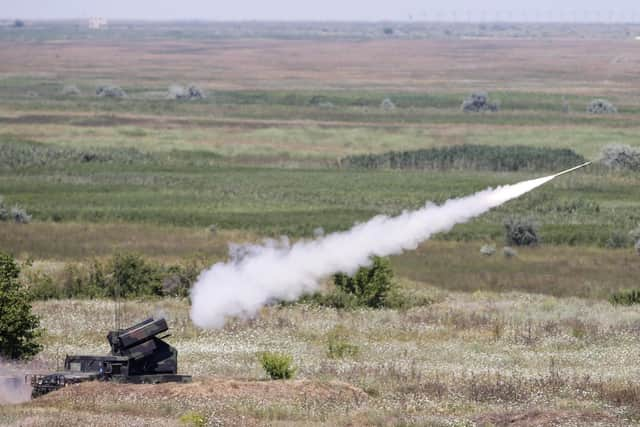What is a cluster bomb? What are vacuum bombs and thermobaric weapons - and has Russia used them in Ukraine?
Russian President Vladimir Putin’s continuing assault on Ukraine from all sides is continuing to spark international outrage and condemnation, with calls for a no-fly zone to be imposed in Ukraine increasing.
Ukrainian leaders and officials are calling on Western forces for further sanctions and assistance in fending off attacks from Russian forces, with satellite footage on Tuesday morning capturing a 40 mile long convoy of Russian military advancing toward the Ukrainian capital, Kyiv.


Advertisement
Hide AdAdvertisement
Hide AdRussian forces have been accused of committing war crimes by Ukrainian officials and human rights organisations after densely-populated residential areas across Ukraine were shelled and confirmed to have been hit by cluster munitions.
On Monday (February 28), the Ukrainian ambassador to the United States also alleged that vacuum bombs had been used in Russia’s attack on Ukraine.
But what are vacuum and cluster bombs? And why is their potential deployment by Russia in Ukraine considered a war crime?
Here’s what you need to know.
What is a vacuum bomb?
Vacuum bombs, also known as thermobaric weapons, withdraw oxygen from the air around them to create an explosion with a longer blast wave at a much higher temperature which means they have the potential to vaporise human bodies.
Rather than using a mix of fuel and oxygen within the bomb itself, thermobaric weapons consist largely of fuel – carrying more energy and having the potential to cause great destruction when launched in field operations to destroy bunkers, tunnels and foxholes.
Developed in the mid-20th century, vacuum bombs have been used by global powers such as the US in the Vietnam War, as well as in Iraq and Afghanistan.
What is a cluster bomb?
While vacuum bombs are those that are 100% fuel and explode into a high-temperature, high-impact combustion with surrounding oxygen, cluster bombs are those which contain multiple submunitions which open mid-air and explode on impact.
Weapons systems delivering clusters of explosive submunitions are collectively known as cluster munitions and can deliver hundreds or thousands of submunitions in a single attack, so are often favoured in large-scale military operations seeking to destroy widespread territory over single, targeted munition attacks.
Advertisement
Hide AdAdvertisement
Hide AdThey can be delivered by missiles and ground artillery, but are also dropped from planes onto generic targeted areas or terrain.
In contrast to vacuum bombs, which are considered useful in targeting harder to reach ground operations and military sites, cluster bombs are often deployed to take out military personnel across large sections of battlefields.
Many of the submunitions are known to not explode on impact and remain unexploded on the ground, posing a further fatal risk to any civilians who might pick them up or be nearby.
But it is because of this wider spread and increased reach, killing or seriously wounding many potential civilians, that their use provokes international condemnation.
Are thermobaric and cluster bombs banned?
Thermobaric weapons such as vacuum bombs are banned internationally as per the terms of the Geneva Convention, regarding indiscriminate weapons.
According to international humanitarian law, states should not use weapons such as cluster bombs or nuclear weapons which are incapable of distinguishing between civilians and military personnel.
This bans the use of weapons which are by their nature and impact indiscriminate in who they kill or impact, in non-international armed conflicts such as the current Russia-Ukraine war.
Cluster bombs also became subject to a global campaign to ban the munitions, resulting in the Convention on Cluster Munitions signed by multiple countries in August 2010.
Advertisement
Hide AdAdvertisement
Hide AdHowever, while there are 110 signatories of the Cluster Munitions Convention, the US, Ukraine and Russia are absent from the international treaty banning the use of cluster bombs, requiring clearing of areas contaminated by munitions within 10 years and the destruction of cluster munition reserves within eight years.
There are 74 states in total which are not party to the Convention.
Did Russia use thermobaric weapons in Ukraine?
Many countries in the past have used both vacuum and cluster bombs as part of their attacks on enemy territory in the past, with the US and Russia among them.
According to Reuters, Ukraine's US ambassador Monday accused Russia of deploying vacuum bombs in Ukraine.

